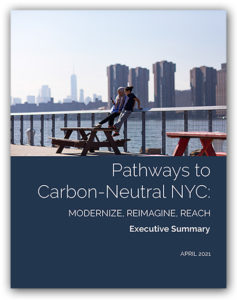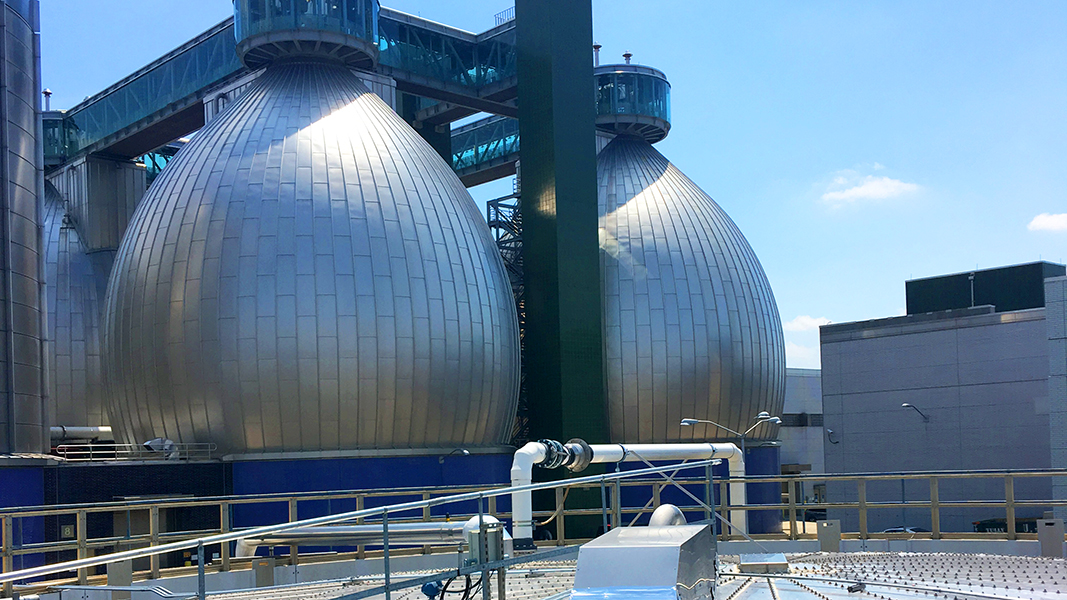Top: Newtown Creek (Brooklyn, New York) wastewater treatment plant anaerobic digesters.
 New York City (NYC) can achieve carbon neutrality by 2050 through a dramatic ramp-up of renewable energy, deep emissions cuts across its building and transportation sectors, and transitioning to low carbon fuels, according to a joint study led by the Mayor’s Office of Sustainability and the two major utilities serving NYC, Con Edison and National Grid. The study, “Pathways to Carbon Neutral NYC,” analyzed three pathway scenarios to understand the opportunities, risks and tradeoffs for advancing programs and policies promoting energy efficiency, electrification, and renewable electricity and gas. The report does not make policy recommendations, but highlights multiple strategies that could help the City meet its energy and climate goals. The utilities — essential partners in supporting citywide decarbonization — will consider these findings as they work toward a net zero future for all the communities they serve.
New York City (NYC) can achieve carbon neutrality by 2050 through a dramatic ramp-up of renewable energy, deep emissions cuts across its building and transportation sectors, and transitioning to low carbon fuels, according to a joint study led by the Mayor’s Office of Sustainability and the two major utilities serving NYC, Con Edison and National Grid. The study, “Pathways to Carbon Neutral NYC,” analyzed three pathway scenarios to understand the opportunities, risks and tradeoffs for advancing programs and policies promoting energy efficiency, electrification, and renewable electricity and gas. The report does not make policy recommendations, but highlights multiple strategies that could help the City meet its energy and climate goals. The utilities — essential partners in supporting citywide decarbonization — will consider these findings as they work toward a net zero future for all the communities they serve.
The pathway scenarios, which have distinct technology deployment strategies, include an “Electrification” path focused on electrifying building heating systems and vehicles; a “Low Carbon Fuels” pathway that relies more on renewable natural gas (RNG) and hydrogen; and a “Diversified” pathway that looks at what might be achievable by pursuing the key elements from the first two strategies at the same time. Each pathway is projected to reduce emissions by at least 80 percent by 2050 (on a 2005 baseline), and the Diversified Pathway could take the reductions beyond 90 percent. In 2020, NYC emitted about 56.5 million tons of carbon dioxide equivalent; that is projected to fall to 6.7 million tons in 2050 under the Diversified Pathway, even as the City’s population grows.
While NYC is already on a clean energy path, the study points to additional steps that could be needed to meet a net-zero target:
- Energy efficiency improvements to more than 900,000 buildings and electrification of heating and hot water in up to 642,000 buildings.
- Aggressive adoption of all-electric cars, reaching 375,000 in 2030 and more than 1.5 million in 2050. New York will need at least 800,000 Level 2 chargers by midcentury to accommodate the electric vehicles, and another 60,000 fast-charging stations if larger trucks are electrified.
- A “dramatic switch” to renewable power generation, as well as a significant adoption of energy storage to help meet demand for electricity when solar panels and wind turbines are not producing. By 2040, the proportion of electricity from fossil fuels will fall to nothing, from 60 percent today.
- A transition toward low carbon fuels such as RNG and hydrogen to leverage the network for the remaining gas needs, along with rapidly increasing building energy efficiency and electrification.
The study notes that a low carbon fuels gas network could support decarbonization of end uses currently too challenging to electrify, and improve energy system reliability by offering optionality and flexibility. Multiple options for reaching net-zero are discussed, depending on how technologies evolve, and which receive the heaviest emphasis from policymakers and residents.
Major investment will be required to decarbonize NYC, ranging from an estimated $1.5 trillion to $2 trillion between 2020 and 2050. Many of the decarbonization technologies are available and cost-effective today, according to the study. But further innovation would be needed to achieve the reductions projected in each scenario, in areas such as long-duration and seasonal storage, geothermal districts, hydrogen blending, and carbon dioxide removal. Breakthroughs in these or other clean-tech sectors could help fill decarbonization gaps and drive down costs. Scale will also be necessary; for example, low-carbon fuels are available but only in limited amounts.













